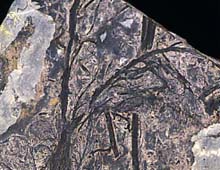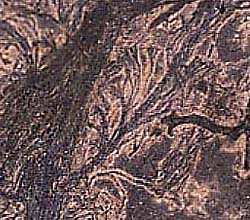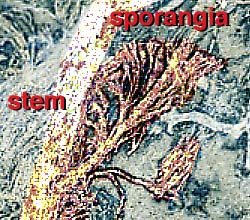 |
 |
The Cladoxylopsida are a collection of plants believed to be closely related to the ferns and the sphenopsids, both of which have living members. In outward appearance, the cladoxylopsids looked very much like their contemporaries, the trimerophytes. Unlike the trimerophytes, however, the cladoxylopsids had a central stem or trunk to which smaller lateral branches were attached. In contrast, the trimerophytes were often shrubbier, with many equal branches and no central trunk.
All fossils of cladoxylopsids are Middle Devonian to Early Carboniferous. Most fossils of this group are little more than structurally preserved stems. In fact, the group does not seem to have produced leaves at all. If this is correct, it would likely mean that the leaves of ferns and sphenophytes evolved independently of the leaves in seed plants. There is even some suggestion that the leaves in the major groups of ferns may have evolved independently of each other on stem-only ancestors!
 |
 |
Fern ancestor? : At left, a fossil of Calamophyton. At right, a fossil of Pseudosporochnus nodosus from the Devonian of Belgium. Unlike structurally simpler plants such as zosterophylls and trimerophytes, members of the Cladoxylopsida had a central stem system to which the side branches were attached.
We include two orders in the Cladoxylopsida (Cladoxylales and Hyeniales), but this is a classification more of convenience that of any certainty about evolutionary relationships of this group. The Iridopteridales and Rhacophytales, for instance, share some characteristics with the cladoxylopsids, but no one really knows where these other groups go. It is not even certain that the Cladoxylales and Hyeniales together constitute an evolutionary group.
The Cladoxylales are the more difficult group to associate with either ferns or sphenophytes. The genus Cladoxylon was first described in 1856, and contains many fossils from the Middle Devonian to Lower Carboniferous. Plants were probably less than 30 cm. tall, with stems about three to six cms. in diameter. The primary xylem (water-conducting tissue) of the stem consists of many individual strands which separate and rejoin as they pass upwards through the stem. In some species, the central primary xylem tissue is surrounded by a zone of secondary xylem (wood).
Another member of the Cladoxylales, Pseudosporochnus, is one of the best known cladoxylopsids. It is usually reconstructed as a small tree with a central trunk supported by abundant roots, and bearing a crown of frond-like branches. At three meters tall, it was among the tallest of plants in the Middle Devonian.
The Hyeniales are known only from the Middle Devonian. In the past, this group was thought to be ancestral to the Sphenopsida based on their overall structure and organization, but more recent studies show their internal anatomy was more like that of the ferns. The genus Hyenia was a rhizomatous plant, much like modern ferns and sphenopsids. A main stem system spread horizontally on or under the ground, and produced smaller stem branches that grew upwards from this rhizome. These vertical branches bore sporangia or small leaf-like branches. Another genus of Hyeniales is Calamophyton, a much larger plant whose species grew from 60 cm to perhaps three meters tall. Calamophyton had a scattered multitude of vascular tissue strands in its stem, which has caused some people to think of the Hyeniales as being more closely related to the ferns.
 |
 |
Sporangia : On the left, a close up of the sporangia of Pseudosporochnus nodosus. On the right, a labelled false color image showing the location of the cluster of sporangia and the stem to which it is attached. Unlike zosterophylls and trimerophytes, the Cladoxylopsida produced sporangia in clusters on side branches, a feature also seen in early ferns.
One important character, however, links the Cladoxylopsida with the ferns and sphenopsids, namely the development of mesarch protoxylem confined to the outer lobed ends of the xylem bundles. In simple terms, the water-conducting vascular tissue begins its development well away from the center of the stem, and each strand of such tissue develops mature cells in the center first, rather than toward the outer or inner edge as in most other plants.
Both ferns and sphenopsids share a number of other key features with the Cladoxylopsida, yet are very unlike each other structurally and anatomically. Likewise, the Cladoxylopsida possess a mix of features of the two living groups, and are therefore difficult to interpret. Any individual character of a particular species could associate a given cladoxylopsid with either the ferns or sphenophytes, but the combination of characters in the Cladoxylopsida makes it more likely that it is a basal group (evolutionary "grade") not directly associated with the origin of either ferns or sphenophytes.

T. N. Taylor & E. L. Taylor, 1993. The Biology and Evolution of Fossil Plants. Prentice Hall, New Jersey, USA.

